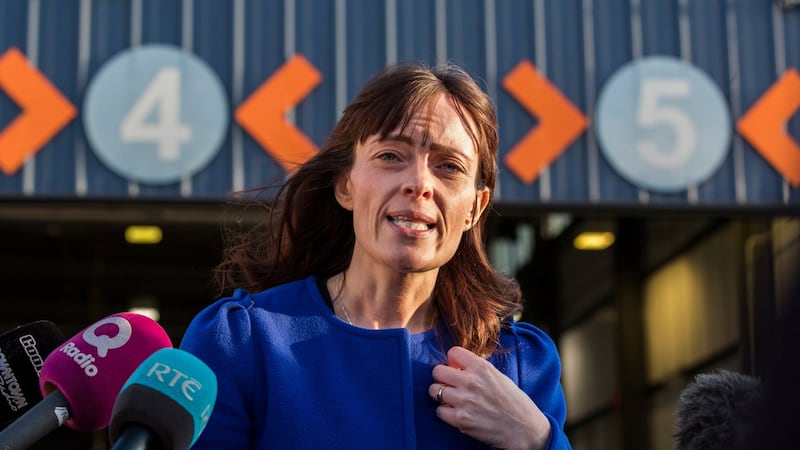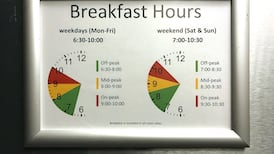Some perspective is needed on plans for cross-Border high-speed rail.
Engineering consultancy Arup was appointed this week to conduct the All-Ireland Strategic Rail Review, on behalf of Minister for Transport Eamon Ryan and Stormont’s SDLP infrastructure minister Nichola Mallon.
While the review will examine improving the network across the island, the flagship programme both governments have been promoting is a €15 billion high-speed “spine” linking Belfast, Dublin and Cork.
Governments wasted years spoofing about building a TGV instead of making unglamorous but essential upgrades
Mallon rarely mentions this without adding a high-speed extension to Derry; Ryan adds another to Limerick. A further line from Dublin to Letterkenny via Navan and Derry was reportedly discussed during Coalition formation talks. The Belfast-Cork line made it into the Coalition agreement and the Taoiseach’s “shared island” agenda, as was unavoidable.
Conducting a feasibility study into this line is one of the Irish Government’s main commitments in last year’s New Decade, New Approach deal to restore northern devolution. The line also gets a mention in the National Development Plan and the National Planning Framework, both serving the Government’s long-term Project Ireland 2040.
On Tuesday, the Cabinet pledged to invest €300 billion in infrastructure over the next two decades, including an extra €45 billion this decade above initial plans. The projected cost of the cross-Border line is not out of proportion to these numbers.
However, we have heard it all before: after the last strategic rail review in 2003, ministers spoke of hourly high-speed services from Dublin to Belfast and Cork.
The best perspective on such grand political plans comes from Irish Rail’s own 20-year strategic review, commissioned from engineering consultancy Aecom and published in 2011. This found there was no justification for high-speed rail anywhere in Ireland, based on estimates of population and growth up to 2030. Of all the many new conventional lines being proposed at the time, the only one found worth considering was between Athenry and Tuam.
Improvements to speed were urged everywhere, but only because intercity rail journeys are extraordinarily slow compared to travelling by car. More frequent services were judged equally important.

Not viable
Although the Dublin-Belfast service is one of the worst on the island in terms of frequency and speed compared to population catchment, the 2011 report still found the only viable improvement was getting journey times down to two hours, a reduction of 20 minutes, through “a limited set of investments” – mainly upgrading sections of track that currently require speed restrictions.
The report envisaged long-term electrification of the core intercity network but ruled this out for Dublin-Belfast as uneconomic, even when electric trains were to be purchased for everywhere else.
This should be considered the rail industry’s view as opposed to the politician’s view. It might be accused of lacking ambition but it could also be praised for realism: getting all intercity journeys down to about two hours, with at least an hourly service, on reliable, comfortable trains. This was not achieved on the Belfast-Dublin route, which has become less reliable since 2011. There must be an extent to which this is because governments wasted years spoofing about building a TGV instead of making unglamorous but essential upgrades.
Similar criticism can be levelled at Stormont. Mallon is in the process of appointing an independent infrastructure commission to drive a more strategic overview of investment and bypass power-sharing silos and rivalries. The UK government is offering billions of pounds for national infrastructure under its “union connectivity” and “levelling up” policies.
Nationalists have condemned this as meddling with devolution but the independent commission could help Mallon get around that concern. For all the attention and laughter at British prime minister Boris Johnson’s tunnel to Scotland, it receives only a token study in the Union Connectivity Review, while cross-Border rail gets a specific listing – ironic, given the constitutional politics involved.
Alas, Mallon supplied perspective on this on Monday by launching a public consultation on a new high-quality bus route across Belfast. Most of the route is already a high-quality bus lane and funding was agreed in outline three years ago, yet it is not due to open until 2027. What is the chance of building a TGV to Newry?
In fairness to the minister, she has begun referring to “higher-speed” as opposed to high-speed rail – a technical term for piecemeal improvements to conventional lines to get average speeds up to about 100mph.
It is an achievable goal for the cross-Border service if Mallon and Ryan sit down with their rail industry leaders and start working through the obvious problems: weak sections of tracks, clapped-out engines and carriages, and the congested line through north Dublin. Translink and Iarnród Éireann costed it themselves in a 2018 proposal at £239 million over five years.
This would still be a major project that could inspire the public, North and South, with the right promotion and branding. It would certainly be more inspiring that a high-speed line that is clearly never going to be built.









